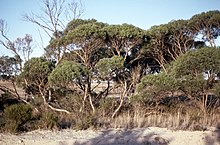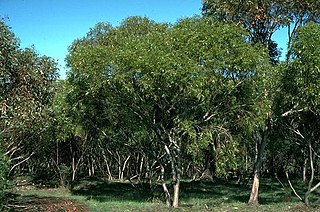
Eucalyptus oraria, commonly known as ooragmandee, is a species of mallee that is endemic to coastal and near-coastal areas of Western Australia. It has smooth greyish bark, sometimes with rough, flaky bark on the base of the trunk, lance-shaped adult leaves, flower buds in groups of nine or more, white flowers and barrel-shaped fruit.
Eucalyptus dolorosa, commonly known as the Mount Misery mallee or Dandaragan mallee, is a species of eucalypt that is endemic to Western Australia. It is a mallee with a short skirt of rough flaky bark at the base of the trunk, smooth pale greyish brown above, lance-shaped to curved adult leaves, flowr buds in groups of seven, white flowers and cup-shaped to spherical fruit.
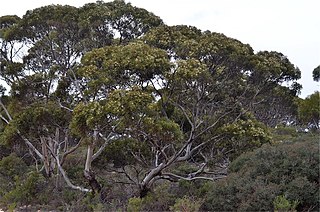
Eucalyptus gracilis, commonly known as yorrell or white mallee, is a species of mallee or small tree endemic to Australia, where it is found in south-western New South Wales], Victoria, South Australia and Western Australia. It has smooth white bark, usually with rough, fibrous or flaky bark on the lower stems, linear to narrow lance-shaped adult leaves, flower buds in group of between seven and eleven and cup-shaped, cylindrical or barrel-shaped fruit.

Eucalyptus × balanites, commonly known as Cadda Road mallee, is a tree or a mallee that is endemic to a small area of the south-west of Western Australia. It has rough, corky or flaky bark, lance-shaped adult leaves, flower buds in groups of eleven, creamy-white flowers and hemispherical to cup-shaped fruit.
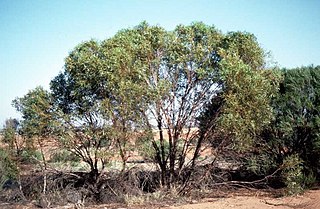
Eucalyptus brevipes, commonly known as the Mukinbudin mallee, is a mallee that is endemic to Western Australia. It has coarse, fibrous to flaky back on the trunk and larger branches, smooth grey to pinkish bark above. The adult leaves are linear to narrow lance-shaped, the flower buds are arranged in groups of seven, the flowers are white and the fruit is cylindrical or barrel-shaped.
Eucalyptus crispata, commonly known as the Yandanooka mallee, is a species of tall mallee that is endemic to a small area on the east coast of Western Australia. It has a stocking of rough bark near the base of its trunk, smooth grey bark above, lance-shaped adult leaves, flower buds in groups of between nine and eleven, whitish to yellowish cream flowers and cup-shaped, barrel-shaped or hemispherical to cylindrical fruit.
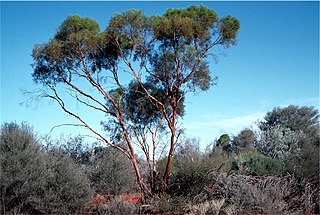
Eucalyptus formanii, commonly known as Die Hardy mallee, Forman's mallee, or feather gum, is a species of tree or mallee that is endemic to Western Australia. It has rough bark over most, or all of its trunk, smooth bark above, linear adult leaves, flower buds in groups of seven or nine, creamy white flowers and cup-shaped to hemispherical fruit.

Eucalyptus johnsoniana, commonly known as Johnson's mallee, is a species of mallee that is endemic to Western Australia. It has smooth, greyish brown bark, sometimes with flaky to fibrous brownish bark at the base, lance-shaped adult leaves, flower buds in groups of seven, creamy white flowers and shortened spherical fruit with an unusually small opening.

Eucalyptus jucunda, commonly known as Yuna mallee, is a species of mallee or small tree that is endemic to Western Australia. It has smooth bark, lance-shaped to curved adult leaves, flowering buds in groups of seven or nine, white or cream-coloured flowers and barrel-shaped or shortened spherical fruit with an unusually narrow opening.

Eucalyptus lucasii, commonly known as Barlee box, is a species of mallee that is endemic to central Western Australia. It has smooth bark, sometimes rough near the base, with broadly lance-shaped adult leaves, flower buds mostly in groups of between seven and eleven on a branched peduncle, creamy white flowers and cup-shaped to cylindrical or conical fruit.
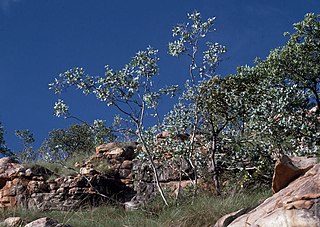
Eucalyptus mooreana, commonly known as Moore's gum, mountain white gum or King Leopold Range mallee, is a species of stunted, straggly tree or mallee that is endemic to the Kimberley region of Western Australia. It has smooth, powdery white bark, a crown of juvenile, sessile, stem-clasping leaves arranged in opposite pairs, flower buds arranged in groups of seven, white flowers and cup-shaped to hemispherical fruit.
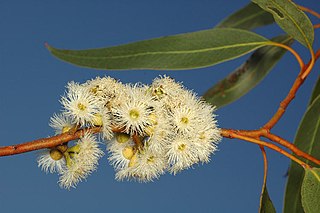
Eucalyptus petraea, commonly known as granite rock box, is a species of mallee or a small tree that is endemic to Western Australia. It has thin, ribbony or flaky to fibrous bark on the lower trunk, smooth greyish above, lance-shaped adult leaves, flower buds usually in groups of seven, creamy white flowers and conical fruit.

Eucalyptus platycorys, commonly known as Boorabbin mallee, is a species of mallee, rarely a small tree, that is endemic to Western Australia. It has rough, dark grey, fibrous and flaky bark on the trunk, smooth greyish bark above, lance-shaped adult leaves, flower buds usually in group of three, creamy white flowers and cup-shaped to cylindrical fruit.
Eucalyptus pruiniramis, commonly known as Jingymia gum or midlands gum is a species of mallee or tree that is endemic to a small area of Western Australia. It usually has rough bark on the lower half of the trunk, smooth bark above, dull green, lance-shaped adult leaves, flower buds in groups of between seven and eleven, white flowers and cylindrical to cup-shaped fruit.

Eucalyptus pruinosa, commonly known as silver box, silver leaf box, apple box or smoke tree, is a species of tree or a mallee that is endemic to northern Australia. The Jaminjung peoples know the tree as yarrirra or jarnbiny, the Jaru as wararn and the Wagiman as wararn. It has rough, fibrous to flaky bark on the trunk and branches, a crown composed of juvenile, glaucous, heart-shaped to broadly elliptical leaves arranged in opposite pairs, flower buds arranged in groups of seven on the ends of branches, creamy white to pale yellow flowers and cylindrical to conical fruit.

Eucalyptus sargentii, commonly known as Salt River gum, is a species of mallet, mallee or small tree that is endemic to Western Australia. It has rough bark on part or all of the trunk, smooth bark above, linear to narrow lance-shaped leaves, flower buds in groups of seven, whitish to creamy yellow flowers and conical fruit.

Eucalyptus suberea, commonly known as Mount Lesueur mallee or cork mallee, is a species of mallee or a small tree that is endemic to a small area on the west coast of Western Australia. It has rough bark on some or all of the trunk, smooth white bark above, lance-shaped adult leaves, flower buds in groups of eleven to twenty or more, white flowers and shortened spherical fruit.
Eucalyptus cuprea, commonly known as the mallee box, is a species of mallee that is endemic to the west coast of Western Australia. It has rough, flaky bark on the base of its trunk, smooth coppery-coloured bark above, lance-shaped adult leaves, flower buds in groups of seven, creamy white flowers and conical to cup-shaped fruit.

Eucalyptus cylindrocarpa, commonly known as the woodline mallee, is a species of mallee that is endemic to Western Australia. It has mostly smooth bark, sometimes with loose fibrous or flaky bark near the base of the trunk, linear to lance-shaped or curved adult leaves, flower buds in groups of seven, nine or eleven and cylindrical to barrel-shaped fruit.
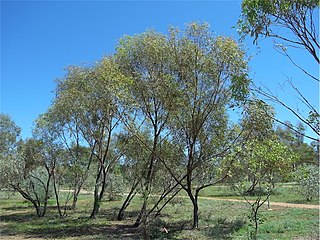
Eucalyptus normantonensis, commonly known as Normanton box, is a species of mallee, rarely a small tree, that is endemic to northern Australia. It has rough, fibrous or flaky bark on some or all of the stems, lance-shaped to curved adult leaves, flower buds in groups of between seven and eleven, white flowers and cylindrical, barrel-shaped or shortened spherical fruit.
